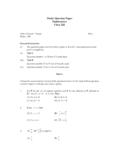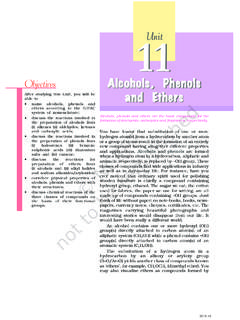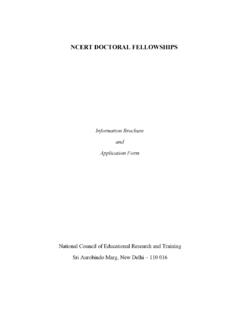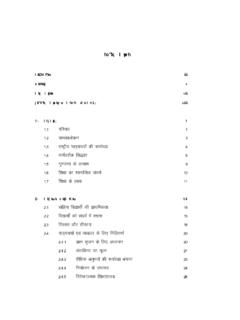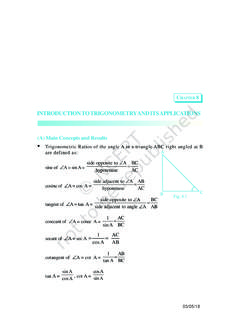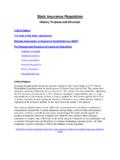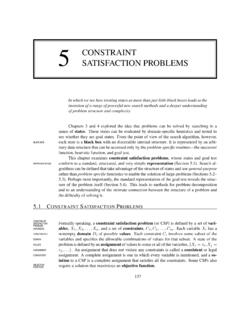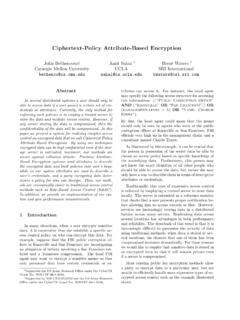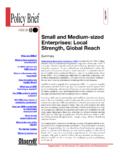Transcription of CELL — S TRUCTURE AND FUNCTIONS Y - NCERT
1 CELL structure AND FUNCTIONSCELL structure AND FUNCTIONSYou have already learnt that thingsaround us are either living ornon-living. Further, you mayrecall that all living organisms carry outcertain basic FUNCTIONS . Can you listthese FUNCTIONS ?Different sets of organs perform thevarious FUNCTIONS you have listed. In thischapter, you shall learn about the basicstructural unit of an organ, which is thecell. cells may be compared to are assembled to make a , cells are assembled to makethe body of every of the CellRobert Hooke in 1665 observed slices ofcork under a simple magnifying is a part of the bark of atree. He took thin slices of cork andobserved them under a microscope. Henoticed partitioned boxes orcompartments in the cork slice (Fig. ).These boxes appeared like a honey-comb.
2 He also noticed that one box wasseparated from the other by a wall orpartition. Hooke coined the term cell for each box. What Hooke observed asboxes or cells in the cork were actuallydead of living organisms could beobserved only after the discovery ofimproved microscopes. Very little wasknown about the cell for the next 150years after Robert Hooke s , we know a lot about cellstructure and its FUNCTIONS because ofimproved microscopes having The CellBoth, bricks in a building and cells inthe living organisms, are basicstructural units [Fig. (a), (b)]. Thebuildings, though built of similar bricks,have different designs, shapes and , in the living world, organismsdiffer from one another but all are madeup of cells . cells in the living organismsare complex living structures unlikenon-living :Fig.
3 :Fig. :Fig. :Fig. :Cork cells as observed byRobert HookeA hen s egg can be seeneasily. Is it a cell or agroup of cells ?2021 22 The egg of a hen represents a singlecell and is big enough to be seen by theunaided show Varietyin Cell Number, Shape andSizeHow do scientists observe and study theliving cells ? They use microscopes whichmagnify objects. Stains (dyes) are usedto colour parts of the cell to study thedetailed are millions of livingorganisms. They are of different shapesand sizes. Their organs also vary inshape, size and number of cells . Let usstudy about some of of CellsCan you guess the number of cells in atall tree or in a huge animal like theelephant? The number runs intobillions and trillions. Human body hastrillions of cells which vary in shapesand sizes. Different groups of cellsperform a variety of made of more than onecell are called multicellular (multi :many; cellular : cell) organisms.
4 Thenumber of cells being less in smallerorganisms does not, in any way, affectthe functioning of the organisms. Youwill be surprised to know that anorganism with billions of cells beginslife as a single cell which is the fertilisedegg. The fertilised egg cell multiplies andthe number of cells increase asdevelopment at Fig (a) and (b). Bothorganisms are made up of a single single-celled organisms are calledunicellular (uni : one; cellular : cell)Fig. : Brick wall and onion peel(a) Brick wall(b) Onion peelA billion is a thousand million. Atrillion is a thousand : (a) Amoeba (b) Paramecium(a)(b)CELL structure AND FUNCTIONS912021 22 SCIENCE92organisms. A single-celled organismperforms all the necessary functionsthat multicellular organisms single-celled organism, likeamoeba, captures and digests food,respires, excretes, grows andreproduces.
5 Similar FUNCTIONS inmulticellular organisms are carried outby groups of specialised cells formingdifferent tissues. Tissues, in turn, teacher may show a permanentslide of amoeba and parameciumunder a microscope. Alternatively,the teacher can collect pond waterand show these organisms bypreparing the of CellsRefer to Fig. (a). How do you definethe shape of amoeba in the figure? Youmay say that the shape appearsirregular. Infact, amoeba has nodefinite shape, unlike other keeps on changing its the projections of varyinglengths protruding out of itsbody. These are called pseudopodia(pseudo : false; podia : feet), as youlearnt in Class VII. These projectionsappear and disappear as amoebamoves or white blood cell (WBC) in humanblood is another example of a single cellwhich can change its shape.
6 But whileWBC is a cell, amoeba is a full fledgedorganism capable of shape would you expect inorganisms with millions of cells ? (a, b, c) shows different cells suchas blood, muscle and nerve of humanbeings. The different shapes are relatedto their specific , cells are round, sphericalor elongated [Fig. (a)]. Some cells arelong and pointed at both ends. Theyexhibit a spindle shape [Fig. (b)]. cells sometimes are quite long. Someare branched like the nerve cell or aneuron [Fig. (c)]. The nerve cellreceives and transfers messages, therebyThe change in shape is due toformation of pseudopodia whichfacilitates movement and helpin capturing :(a) Spherical red blood cellsof humans, (b) Spindleshaped muscle cells ,(c) Long branched nerve cell(a)(b)(c)What advantage doesamoeba derive bychanging shape?
7 2021 22 CELL structure AND FUNCTIONS93the elephant be much bigger than thosein a rat. The size of the cell is related toits function. For example, nerve cells ,both in the elephant and rat, are longand branched. They perform the samefunction, that of transferring structure andFunctionYou have learnt that each livingorganism has many organs. You havestudied in Class VII about the digestiveorgans which together constitute thedigestive system. Each organ in thesystem performs different functionssuch as digestion, assimilation andabsorption. Similarly, different organsof a plant perform specific/specialisedfunctions. For example, roots help in theabsorption of water and , as you have learnt in Class VII,are responsible for synthesis of organ is further made up ofsmaller parts called tissues.
8 A tissue isa group of similar cells performing aspecific realised that an organ is madeup of tissues which in turn, are madeup of cells . The cell in a living organismis the basic structural of the CellCell MembraneThe basic components of a cell are cellmembrane, cytoplasm and nucleus(Fig. ). The cytoplasm and nucleusare enclosed within the cell membrane,also called the plasma membrane. Themembrane separates cells from oneanother and also the cell from thesurrounding medium. The plasmamembrane is porous and allows thehelping to control and coordinate theworking of different parts of the you guess, which part of the cellgives it shape? Components of the cellare enclosed in a membrane. Thismembrane provides shape to the cellsof plants and animals. Cell wall is anadditional covering over the cellmembrane in plant cells .
9 It gives shapeand rigidity to these cells (Fig. ).Bacterial cell also has a cell of CellsThe size of cells in living organisms maybe as small as a millionth of a metre(micrometre or micron) or may be as largeas a few centimetres. However, most of thecells are microscopic in size and are notvisible to the unaided eye. They need tobe enlarged or magnified by a smallest cell is to micrometrein bacteria. The largest cell measuring170 mm 130 mm, is the egg of an a hen s egg. Remove the do you observe? A whitematerial surrounds the yellow material is albumin whichsolidifies on boiling. The yellow partis yolk. It is part of the single can observe this single cellwithout any magnifying the cells in anelephant larger than thecells in a rat?The size of the cells has no relationwith the size of the body of the animal orplant.
10 It is not necessary that the cells in2021 22 SCIENCE94movement of substances or materialsboth inward and order to observe the basiccomponents of the cell, take anonion bulb. Remove the dry pinkcoverings (peels). You can easilyseparate these from the fleshy whitelayers of the bulb with the help offorceps or even with your hand. Youcan also break the onion bulb andseparate out thin layers. Place asmall piece of the thin onion peelin a drop of water on a glass thin layer can be cut intosmaller pieces with the help of ablade or forceps. Add a drop ofmethylene blue solution to the layerand place a coverslip on it. Whileplacing the coverslip ensure thatthere are no air bubbles under thecoverslip. Observe the slide underthe microscope. Draw and label. Youmay compare it with Fig.
